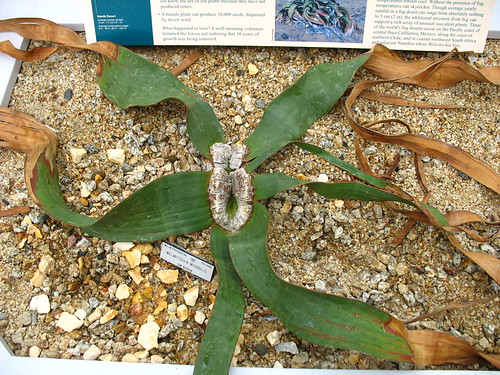 Welwitschias are extraordinary plants and certainly rank among the top ten list of "most bizarre plants on earth."
Welwitschias are extraordinary plants and certainly rank among the top ten list of "most bizarre plants on earth." Welwitschia is a monotypic genus of gymnosperm plant, composed solely of the very distinct Welwitschia mirabilis. The plant, which is considered a living fossil is named after the Austrian botanist Friedrich Welwitsch who discovered it in 1859. The geographic distribution of Welwitschia mirabilis is limited to the Namib desert within Namibia and Angola.
Welwitschia grows from a short, thick, woody trunk, with only two leaves that continuously grow from their base, and a long, thick taproot. After germination, the cotyledons grow to 25–35 mm in length, and are followed shortly afterward by the appearance of two permanent leaves.
These leaves are produced opposite of the cotyledons, and continue to grow throughout the entire life of the plant. They eventually grow to a length of 2–4 m and usually become split into several strap-shaped sections. The species is dioecious, with separate male and female plants. Fertilization, that is, the transfer of the pollen from the male to the female strobili, is carried out by insects that are attracted by "nectar" produced on both male and female strobili
These leaves are produced opposite of the cotyledons, and continue to grow throughout the entire life of the plant. They eventually grow to a length of 2–4 m and usually become split into several strap-shaped sections. The species is dioecious, with separate male and female plants. Fertilization, that is, the transfer of the pollen from the male to the female strobili, is carried out by insects that are attracted by "nectar" produced on both male and female strobili
Watering: The plant absorbs water through structures on its leaves, harvesting moisture originating from dew that forms during the night.
Light: Welwitschia mirabilis needs full sun but it should be under roof when it rains. So it will be great if Welwitschia mirabilis locates in the greenhouse.
Soil: normal soil for cactus and it should be well-drained. If its leave becomes yellow, it means that you water too little.
Propagation: Welwitschia mirabilis is propagated from seed. Fresh seed will germinate in 45-60 days at 85°F (30°C).

No comments:
Post a Comment